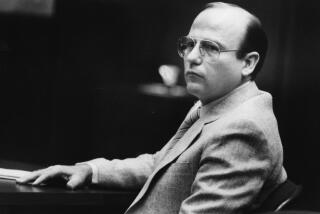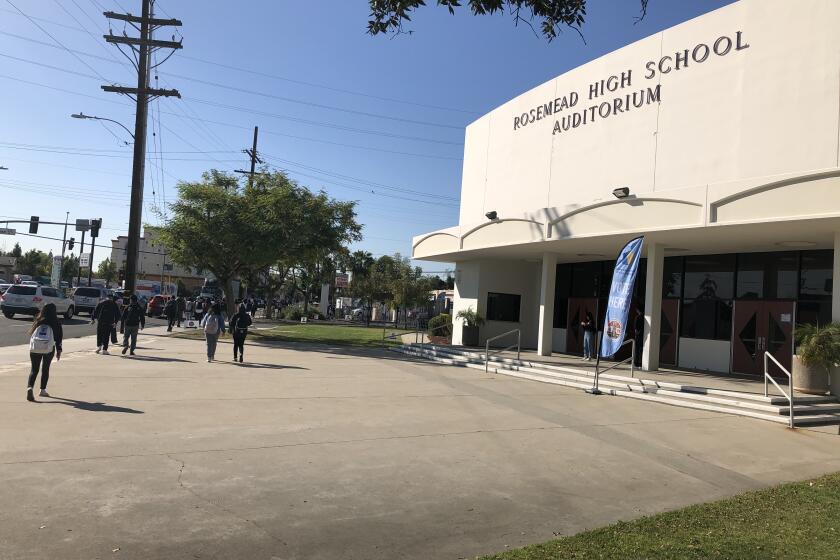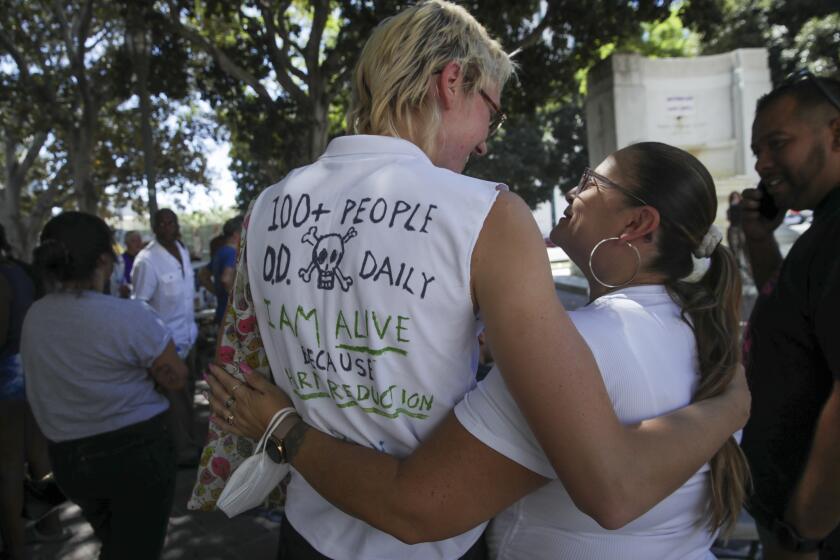City Jails Protect County Inmates
While in Men’s Central Jail in downtown Los Angeles, authorities said, convicted murderer Marcus Adams tried to kill an inmate, assaulted two jailers and threatened to stab another. So when it came time for Adams’ triple-murder trial, prosecutors did not want to take any chances that he would cross paths with other inmates who might testify against him.
Prosecutors eliminated that possibility by housing the witnesses at city lockups in Alhambra and Monterey Park.
“If you are asking them to risk their lives, then you need to show them that you are willing to protect them the best you can,” said Deputy Dist. Atty. Patrick Sequeira, who prosecuted the Adams case.
The tactic worked. But even though one Central Jail inmate was killed this year allegedly by the man he testified against and another slashed after he appeared in court for the prosecution, authorities say it is too costly in most cases to use city jails to hold potental witnesses.
The county covers the cost for inmates housed in the sheriff’s custody, but the district attorney’s office pays roughly $70 to $75 a day out of its budget to house inmates at city jails.
Nevertheless, Los Angeles County Dist. Atty. Steve Cooley has called for the more frequent use of city jails to protect inmate witnesses in certain criminal cases.
“You’re isolating someone who otherwise might be vulnerable from someone who might want to retaliate against them,” he said. “You are putting distance between the predator and the potential victim.”
Los Angeles County Superior Court Judge Norman P. Tarle said there should be ongoing contracts with some city jails.
“The central priority should be to keep these people safe,” said Tarle, who recently presided over a jailhouse murder case. “Nobody deserves to die that way, especially the ones who are cooperating.”
Monterey Park officials have worked with prosecutors for several years to house certain inmates. The likelihood of something happening to witnesses at the Monterey Park jail is far less than at County Jail, said Steve Coday, the city’s jail manager.
“It’s becoming more of a trend for city jails because of the state budget situation,” Coday said. “Everyone is trying to find more ways to generate revenue.”
But the city jails are limited, both in size and staff. Often, they are not equipped to handle inmates with medical or mental health problems, or to hold witnesses for several months at a time. Despite the benefits of the added revenue, Alhambra jail administrator J.R. Lozoya said he has to reject violent inmates because his staff does not have the training to deal with them.
Sheriff’s Chief Chuck Jackson acknowledged that there is always a potential for error in the county’s huge jail system. He said city jails could ensure the safety of witnesses by completely separating them from the defendants they testify against. But it does create some problems for the Sheriff’s Department.
“It makes us a little uncomfortable if an inmate that is our responsibility is being housed in somebody else’s jail,” Jackson said. “They are charged to our care when they have a county booking number.”
Superior Court Judge David S. Wesley, who presides over the criminal courts, said the cost would be prohibitive -- for the courts or the district attorney’s office -- to frequently place inmates in city jails.
“If the Sheriff’s Department can’t do the job, then maybe something else should be looked at,” Wesley said. “Right now, I believe they can and they are making the necessary adjustments.”
Housing inmates in city jails also causes more work for investigators, who drive the witnesses back and forth to court. They have even flown to state prisons to pick up inmates.
“It’s a royal pain,” said Los Angeles Police Det. Bill Smith. “It really takes a lot of legwork.”
But Smith said he has more access to witnesses in city lockups. And of course, he said, witnesses prefer the smaller jails. “It’s luxury,” he said. “County Jail is just a human stockyard.”
Housing witnesses in city jails is sometimes “the only way to keep people alive,” said Deputy Dist. Atty. Jennifer Snyder.
“These witnesses don’t ask to be put in these positions,” she said. “Asking them to testify puts an enormous burden.”
Securing funding and approval, however, is not easy. In one case, Deputy Dist. Atty. Danette Meyers said she couldn’t get her office, the Superior Court or the Sheriff’s Department to agree to pay for two of her witnesses to be housed separately from co-defendants. Both inmates are now in protective custody in County Jail, but Meyers still fears for their safety.
“Luckily, nothing has happened to either defendant,” she said. “I really worry, because you just never know.”
Sometimes witnesses aren’t transferred out of County Jail until there is a problem. Shane Wilson, who testified against his former co-defendants in a murder case, was transferred after being slashed across the chin by a fellow inmate, a wound that required more than 200 stitches to close.
In the Adams case, the original charges were dropped after the star witness was threatened and refused to testify. It wasn’t until after Adams was convicted of murder in Santa Barbara County that the witness agreed to cooperate. The case was filed again and Adams was tried last year for the 1994 slayings of Lamar Armstrong, Dayland Hicks and Trevon Boyd. The three friends were shot multiple times as they sat in a car near 47th Street and Western Avenue in South Los Angeles.
Deputy Dist. Atty. Sequeira had seen too many witnesses threatened and attacked in County Jail. He said he knew he had to take special precautions with two of his witnesses, both state prison inmates and members of Adams’ gang.
One of the witnesses, who only gave his first name, Chris, said he received several death threats while in County Jail. While waiting for the bus one day, he said, two inmates came toward him with knives. A deputy intervened, but Chris said he always expected the worst.
“In a confined environment, there aren’t too many places you can go,” he said. “If someone really wants to get you, it’s only a matter of time.”
Chris said he finally felt safe at the Alhambra jail. “Nobody even knew I was there,” said Chris, who lives outside the state and said he has since left the gang. “I was tucked away.”
Chris testified at trial, and Adams was convicted of the three murders and sentenced to death.
Sequeira said he tries to use the city jails, rather than housing witnesses in County Jail, in as many of his cases as he can, especially if any of the witnesses has been threatened.
“It does require extra effort and makes these cases more challenging,” he said. “In order to have successful prosecution in many of these cases, you need that extra effort.”
More to Read
Start your day right
Sign up for Essential California for news, features and recommendations from the L.A. Times and beyond in your inbox six days a week.
You may occasionally receive promotional content from the Los Angeles Times.






